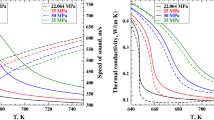Abstract
Low Mach number flows are common and typical in industrial applications. When simulating these flows, performance of traditional compressible flow solvers can deteriorate in terms of both efficiency and accuracy. In this paper, a new high-order numerical method for two-dimensional (2-D) state low Mach number flows is proposed by combining flux reconstruction (FR) and preconditioning. Firstly, a Couette flow problem is used to assess the efficiency and accuracy of preconditioned FR. It is found that the FR scheme with preconditioning is much more efficient than the original FR scheme. Meanwhile, this improvement still preserves the numerical accuracy. Using this new method and without the Boussinesq assumption, classic natural convection is directly simulated for cases of small and large temperature differences. For the small temperature difference, a p and h refinement study is conducted to verify the grid convergence and accuracy. Then, the influence of the Rayleigh number (Ra) is analyzed. By comparing with the reference results, the numerical results of preconditioned FR is very close to that calculated by incompressible solvers. Furthermore, a large temperature difference test case is calculated and analyzed, indicating this method is not limited by the Boussinesq assumption and is also applicable to heat convection with large temperature differences.







Similar content being viewed by others
References
Chorin, A.J.: A numerical method for solving incompressible viscous flow problems. J. Comput. Phys. 2, 12–26 (1967). https://doi.org/10.1016/0021-9991(67)90037-X
Turkel, E.: Preconditioning techniques in computational fluid dynamics. Annu. Rev. Fluid Mech. 31, 385–416 (1999). https://doi.org/10.1146/annurev.fluid.31.1.385
Ke, G., Aulisa, E., Bornia, G., et al.: Block triangular preconditioners for linearization schemes of the Rayleigh-Bénard convection problem. Numer. Linear Algebra Appl. 24, e2096 (2017). https://doi.org/10.1002/nla.2096
Bhowmik, S.K.: A multigrid preconditioned numerical scheme for a reaction-diffusion system. Appl. Math. Comput. 254, 266–276 (2015). https://doi.org/10.1016/j.amc.2014.12.062
Ke, G., Aulisa, E.: New preconditioning techniques for the steady and unsteady buoyancy driven flow problems. J. Comput. Phys. 371, 244–260 (2018). https://doi.org/10.1016/j.jcp.2018.05.037
Weiss, J.M., Smith, W.A.: Preconditioning applied to variable and constant density flows. AIAA J. 33, 2050–2057 (1995). https://doi.org/10.2514/3.12946
Choi, Y.H., Merkle, C.L.: The application of preconditioning in viscous flows. J. Comput. Phys. 105, 207–223 (1997). https://doi.org/10.1006/jcph.1993.1069
Campobasso, M.S., Drofelnik, J.: Compressible Navier–Stokes analysis of an oscillating wing in a power-extraction regime using efficient low-speed preconditioning. Comput. Fluids. 67, 26–40 (2012). https://doi.org/10.1016/j.compfluid.2012.07.002
Huynh, H.T.: A flux reconstruction approach to high-order schemes including discontinuous Galerkin methods. AIAA Paper, 2007–4079 (2007). https://doi.org/10.2514/6.2007-4079
Huynh, H.T.: A reconstruction approach to high-order schemes including Discontinuous Galerkin for diffusion. AIAA Paper, 2009–403 (2009). https://doi.org/10.2514/6.2009-403
Wang, Z.J., Gao, H.: A unifying lifting collocation penalty formulation including the discontinuous Galerkin, spectral volume/difference methods for conservation laws on mixed grids. J. Comput. Phys. 228, 8161–8186 (2009). https://doi.org/10.1016/j.jcp.2009.07.036
Jameson, A.: A proof of the stability of the spectral difference method for all orders of accuracy. J. Sci. Comput. 45, 348–358 (2010). https://doi.org/10.1007/s10915-009-9339-4
Vincent, P.E., Castonguay, P., Jameson, A.: A new class of high-order energy stable flux reconstruction schemes. J. Sci. Comput. 47, 50–72 (2011). https://doi.org/10.1007/s10915-010-9420-z
Castonguay, P., Williams, D.M., Vincent, D.M., et al.: Energy stable flux reconstruction schemes for advection-diffusion problems. Comput. Methods Appl. Mech. Eng. 267, 400–417 (2013). https://doi.org/10.1016/j.cma.2013.08.012
Williams, D.M., Castonguay, P., Vincent, P.E.: Energy stable flux reconstruction schemes for advection-diffusion problems on triangles. J. Comput. Phys. 250, 53–76 (2013). https://doi.org/10.1016/j.jcp.2013.05.007
Huynh, H.T., Wang, Z.J., Vincent, P.E., et al.: High-order methods for computational fluid dynamics: a brief review of compact differential formulations on unstructured grids. Comput. Fluids 98, 209–220 (2014). https://doi.org/10.1016/j.compfluid.2013.12.007
Wang, Z.J.: High-order methods for the Euler and Navier–Stokes equations on unstructured grids. Prog. Aerosp. Sci. 43, 1–41 (2007). https://doi.org/10.1016/j.paerosci.2007.05.001
Lu, Y.L., Wan, H., Zhuang, L.X.: Three dimensional finite element analysis for Rayleight–Bénard convection in rectangular enclosures. Acta Mech. Sin. 2, 114–125 (2002). https://doi.org/10.1007/BF02487466
He, X.Z., Tong, P.: Space-time correlations in turbulent Rayleigh–Bénard convection. Acta Mech. Sin. 4, 457–467 (2014). https://doi.org/10.1007/s10409-014-0068-z
Kizildag, D., Rodrguez, I., Oliva, A., et al.: Limits of the Oberbeck–Boussinesq approximation in a tall differentially heated cavity filled with water. Int. J. Heat Mass Transf. 68, 489–499 (2014). https://doi.org/10.1016/j.ijheatmasstransfer.2013.09.046
Roe, P.L.: Approximate Riemann solvers, parameter vectors, and difference schemes. J. Comput. Phys. 43, 357–372 (1981). https://doi.org/10.1016/0021-9991(81)90128-5
Liou, M.S., Steffen, C.: A new flux splitting scheme. J. Comput. Phys. 107, 23–39 (1993). https://doi.org/10.1006/jcph.1993.1122
Toro, E.F., Spruce, M., Speares, W.: Restoration of the contact surface in the HLL-Riemann solver. Shock Waves 4, 25–34 (1994). https://doi.org/10.1007/BF01414629
Cockburn, B., Shu, C.W.: The local discontinuous Galerkin method for time-dependent convection-diffusion systems. SIAM J. Numer. Anal. 35, 2440–2463 (1998). https://doi.org/10.1137/S0036142997316712
Bassi, F., Rebay, S.: High-order accurate discontinuous finite element solution of the 2D Euler equations. J. Comput. Phys. 138, 251–285 (1997). https://doi.org/10.1006/jcph.1997.5454
Peraire, J., Persson, P.O.: The compact discontinuous Galerkin method for elliptic problems. SIAM J. Sci. Comput. 30, 1806–1824 (2009). https://doi.org/10.1137/070685518
Bassi, F., Rebay, S.: A high-order discontinuous Galerkin method forcompressible turbulent flows. In: Cockburn, G.K.B., Shu, C.-W. (eds.) Discontinuous Galerkin Methods: Theory, Computation, and Application. Lecture Notes in Computational Science and Engineering, pp. 77–88. Springer, Berlin (2000)
Davis, G.D.V., Jones, I.P.: Natural convection in a square cavity: a comparison exercise. Int. J. Numer. Methods Fluids 3, 227–248 (1983). https://doi.org/10.1002/fld.1650030304
Dennis, S.C.R., Hudson, J.D.: Compact finite-difference approximations to operators of Navier–Stokes type. J. Comput. Phys. 85, 390–416 (1989). https://doi.org/10.1016/0021-9991(89)90156-3
Becker, R., Braack, M.: Solution of a stationary benchmark problem for natural convection with high temperature difference. Int. J. Therm. Sci. 41, 428–439 (2002). https://doi.org/10.1016/S1290-0729(02)01335-2
Vierendeels, J., Riemslagh, K., Dick, E.: A multigrid semi-implicit line-method for viscous incompressible and low-Mach number flows on high aspect ratio grids. J. Comput. Phys. 154, 310–341 (1999). https://doi.org/10.1006/jcph.1999.6315
Le Quéré, P., Masson, R., Perrot, P.: A Chebyshev collocation algorithm for 2D non-Boussinesq convection. J. Comput. Phys. 103, 320–335 (1992). https://doi.org/10.1016/0021-9991(92)90404-M
Author information
Authors and Affiliations
Corresponding author
Rights and permissions
About this article
Cite this article
Yu, Y., Liu, F., Zhou, T. et al. Numerical solutions of 2-D steady compressible natural convection using high-order flux reconstruction. Acta Mech. Sin. 35, 401–410 (2019). https://doi.org/10.1007/s10409-018-00835-w
Received:
Revised:
Accepted:
Published:
Issue Date:
DOI: https://doi.org/10.1007/s10409-018-00835-w




